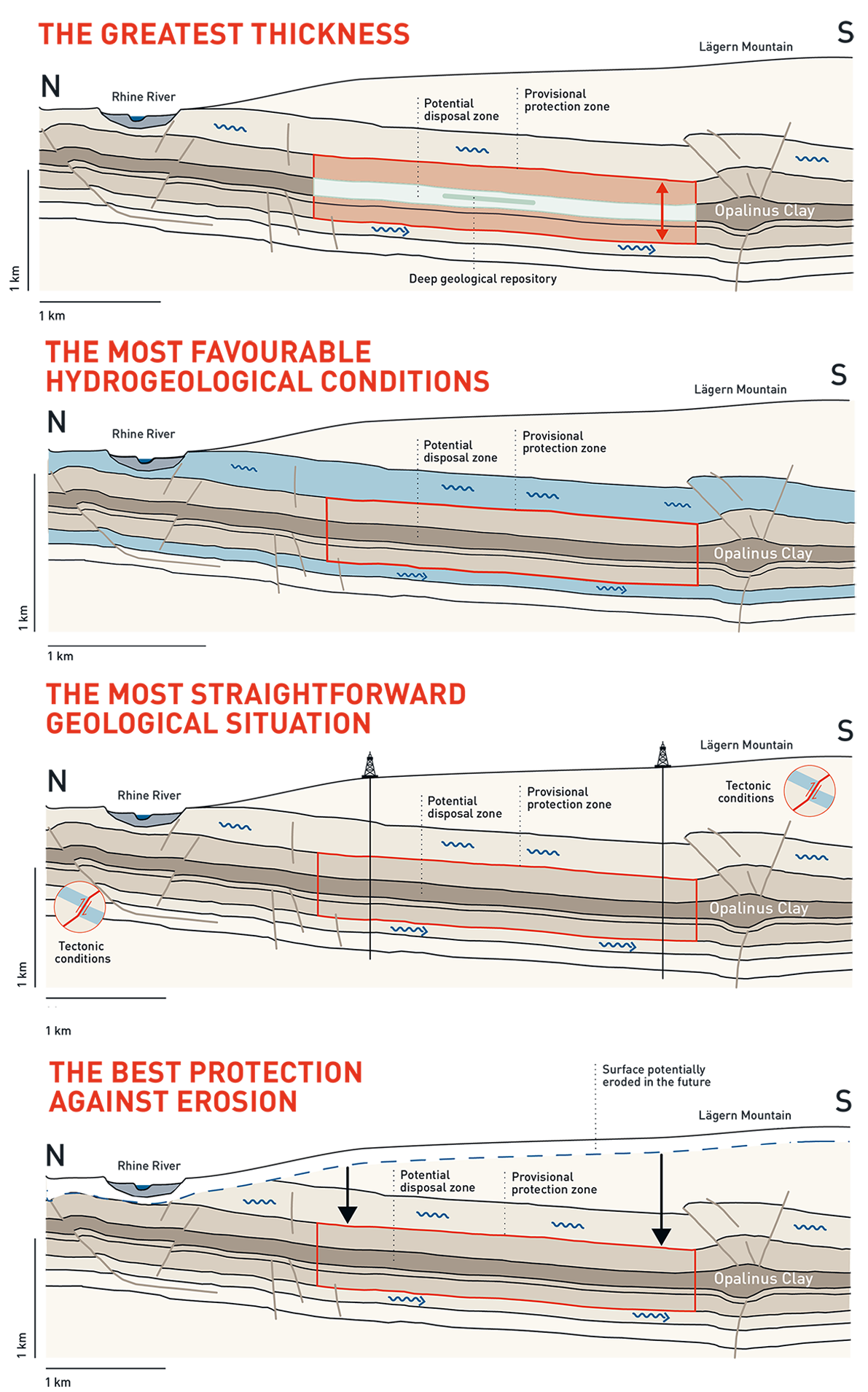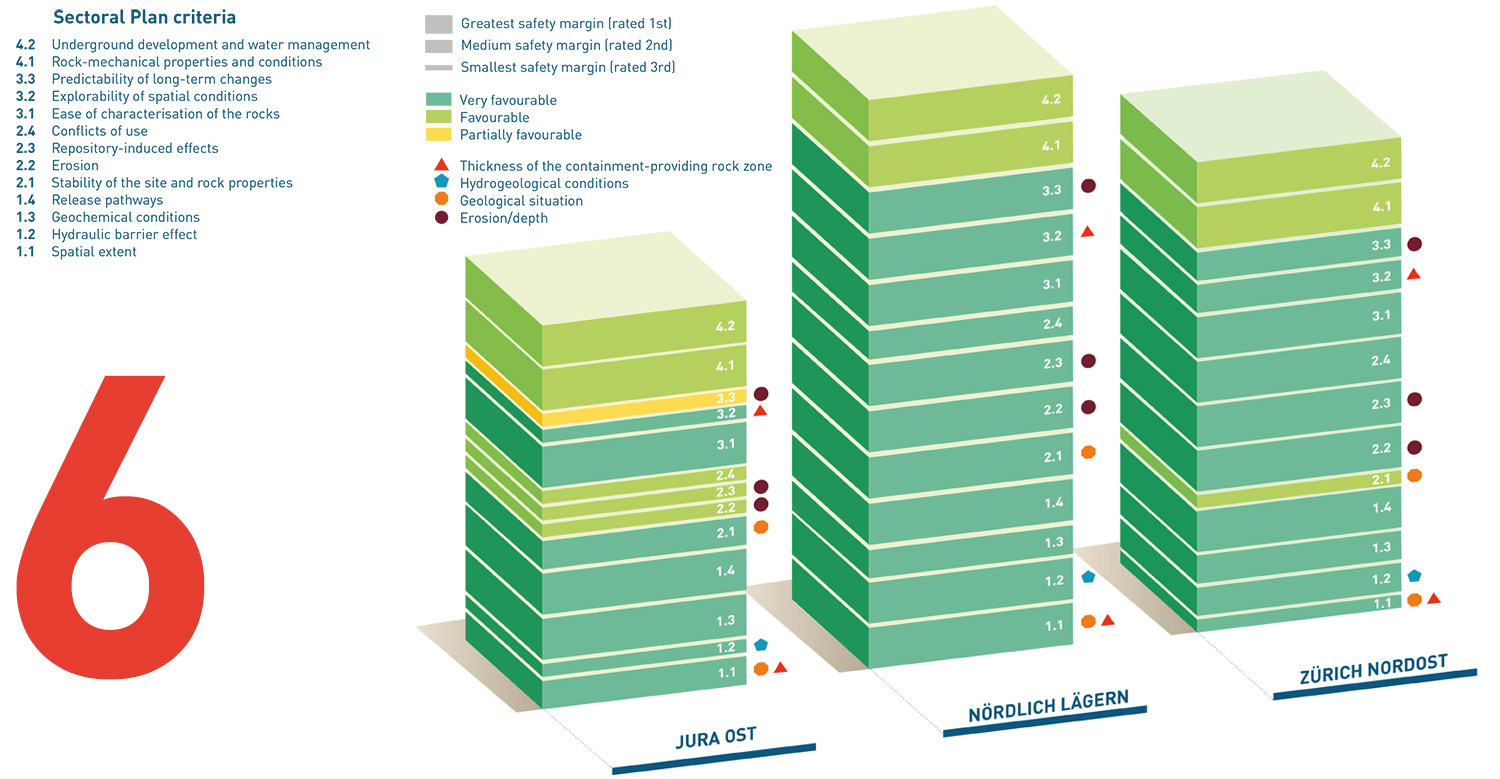The Jura Ost (JO), Nördlich Lägern (NL) and Zürich Nordost (ZNO) siting regions are all suitable for the construction of a deep geological repository, with sufficient margins to ensure safety in the long term. In Stage 2 of the Sectoral Plan process, preliminary safety analyses demonstrated that the protection criteria can be met in all of these siting regions.
The key properties of the engineered and geological barriers present in all siting regions form the basis for demonstrating post-closure safety. The decisive features for selecting NL were determined based on extensive geological investigations carried out at the beginning of Stage 3. With a view to the preparations for the general licence applications, this led to the announcement of the most suitable repository site in autumn 2022 based on the decisive features summarised in terms of quality, stability and flexibility.
The siting regions were investigated in great detail by means of 3D seismic surveys, a deep borehole campaign and numerous Quaternary boreholes as well as accompanying field measurements.
The key decision factor for the selection of NL (argument report as per pdf ENSI 33/649(1.39 MB) ) as the repository site are the following features of the containment-providing rock zone:
- the greatest thickness
- the most favourable hydrogeological conditions
- the most straightforward geological situation
- the best protection against erosion
The Sectoral Plan defines 13 criteria that must be evaluated as part of the site selection process with regard to safety and engineering feasibility. The most suitable siting region for an HLW and an L/ILW repository must be determined by means of a positive selection process. As all siting regions are suitable, the focus is on selecting the siting region that offers the greatest safety margins. The qualitative advantages of NL are confirmed within the framework of assessing the 13 criteria, which are assigned to four criteria groups.

THE SELECTION CRITERIA
Criteria group 1 is related to the barrier function of the containment-providing rock zone. Criteria group 2 assesses how well this barrier function remains ensured over the required time periods, and criteria group 3 assesses the reliability of these geological findings and predictions.
Criteria groups 1 to 3 assess the performance of the geological barrier in the siting region with regard to postclosure safety. Engineering measures can only impact these to a limited extent. The repository induced effects are an exception (Criterion 2.3) as these can be influenced by the repository layout.
Criteria group 4 evaluates the engineering suitability, i.e. technical feasibility. To determine this, pdf provisional repository projects(1.82 MB) were developed for each repository type and each siting region, and an integral assessment of the engineering suitability of the geological subsurface was carried out by means of construction engineering pdf risk analyses(4.68 MB) .
These confirm that the conditions for all repository projects can be controlled from an engineering perspective and that the associated risks can be mastered with known and proven measures used in underground construction, even in the event of deviating geological conditions. In line with the primacy of safety in the Sectoral Plan process, the effort required in this respect is not assessed.
As the distance to the aquifers in NL is greatest overall and the containment-providing rock zone is thickest, there is a qualitative advantage with regard to the spatial extent (Criterion 1.1).
Analyses of the chemical composition of the porewaters and the groundwater in the aquifers show that groundwater circulation in and around the containment-providing rock zone in NL is lowest. As a result, NL has a qualitative advantage in the assessment of the hydraulic barrier effect (Criterion 1.2).
The geological situation is the most straightforward in the potential disposal zone of NL. The rocks, for example, are the most stably bedded. With one possible exception below the Stadlerberg, there are no indications for faults large enough to be mapped with 3D seismic surveys, which is why the spatial extent in NL (Criterion 1.1) is rated best.
Since changes in the geological underground generally take place where weak points already exist, the absence of faults results in an advantage with regard to the stability of the site and rock properties (Criterion 2.1).
The straightforward geological situation is also an advantage for geoscientific investigations and the realisation of the deep geological repository, in particular due to the lower uncertainties when developing long-term predictions and safety analyses. NL, for example, also has the greatest likelihood of additional confining geological units, i.e. a greater safety margin for the underlying confining geological units (Criterion 3.2).
The safety margins with regard to future evolution are greatest in NL. This applies, for example, to repository-induced effects (Criterion 2.3).
With regard to protection against erosion, this issue is important both with a view to the expected future evolution (Criterion 2.2) and to less favourable assumptions (Criterion 3.3).
DECISIVE BARRIER PROPERTIES
The properties of the geological barrier that are decisive for site selection show clear advantages for NL, regardless of the repository type. As the time period for assessment for an L/ILW repository is ten times shorter than for an HLW repository, not all criteria are as relevant in the case of the L/ILW repository.
The greater protection against future erosion is therefore not relevant, but the preservation of long-term barrier integrity with increasing gas pressure is of greater importance than in the case of the HLW repository. Assuming the same repository layout, the greater repository depth in NL provides a greater safety margin when considering repository-induced effects (Criterion 2.3).
Negative interactions between the two disposal areas for HLW and L/ILW in the combined repository can be ruled out due to the generous spatial reserves. Regardless of the repository type, the NL siting region has clear safety-related advantages for post-closure safety due to its geological properties.

